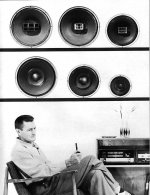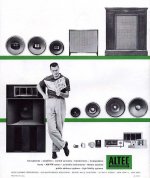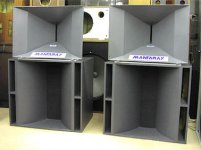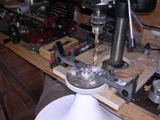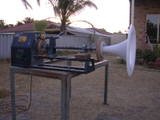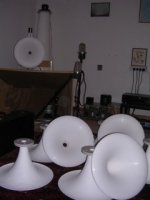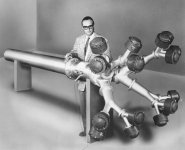Congratulations on getting the 604's up and running. Here's a little souvenir from the 1954 Altec catalog - a mere 55 years ago. I'm sure you'll recognize the speaker at the top left.
Attachments
From the same catalog ...
Actually, I've been talking to Gary Dahl about a simplified system using a pair of 414-16's in separate closed boxes for the bass, the 288+AH425 for the mid/treble, and a 2.5 way crossover (the upper 414 covers 50~800 Hz, the lower 414 covers 50~300 Hz, with a multi-tapped lowpass inductor for the lower driver so the system can be matched to the room).
Although a box gets us back to the bad old world of box colorations again, it's simpler at the conceptual and physical level, since there's no need for bi-amplification and twiddling with room/dipole EQ to get it flat at the listening position. I'm still going ahead with the dipole, but the twin-414 approach has the merits of simplicity, tunability, high efficiency, and only requiring one amplifier per channel.
Actually, I've been talking to Gary Dahl about a simplified system using a pair of 414-16's in separate closed boxes for the bass, the 288+AH425 for the mid/treble, and a 2.5 way crossover (the upper 414 covers 50~800 Hz, the lower 414 covers 50~300 Hz, with a multi-tapped lowpass inductor for the lower driver so the system can be matched to the room).
Although a box gets us back to the bad old world of box colorations again, it's simpler at the conceptual and physical level, since there's no need for bi-amplification and twiddling with room/dipole EQ to get it flat at the listening position. I'm still going ahead with the dipole, but the twin-414 approach has the merits of simplicity, tunability, high efficiency, and only requiring one amplifier per channel.
Attachments
big big thanks to Lynn and all you guys!
Dear Lynn! And hello to all others posting so much valuable information here!
I've found this thread just a few weeks ago, and I'm still struggling to catch up. I'm approaching late 2007 now, unable to increase my reading speed while I'm busy to extract and soak up all the knowledge that's to be found here.
You've managed to answer a ton of my questions before I was only ready to verbalize them.
Thank you!
Now, why am I posting now, without a real connection to what's going on right now? Well, my decision to follow Lynn's plan in building an ultimate speaker is made for quite some time now. And as I understand an esteem his listening experience and based on that his design approach, I'm preparing to follow this path.
These days I've started collecting candidates for the wide range transducer. I'll start auditioning them as soon as I manage to install a pair of open baffles with replaceable boards in my living room. (Remember, I'm behind more than one year, so I do not know anything about midrange horns yet. )
)
The candidates I have or will receive soon are very different, but hopefully interesting:
Beyma 122Nd (my top three favourite, based on specs and paper, with insane driving force and the claim of a beautiful roll-off at very high frequencies)
B&C 8PL21-16 (I wonder how different an 8" may sound)
Tang Band WQ1005D (4 pcs, maybe better as low-mids)
Coral 12L27B (vintage low-mids)
I've been promised some guitar amp 12"s that are replaced, too.
18sound 12NDA520 and Precision Devices PDM.12MBH25 are still sitting the top places of my list.
I'll try to catch up with you and keep you updated about my experience at the same time.
Thanks again for all your great support!
Cheers,
Axel
Dear Lynn! And hello to all others posting so much valuable information here!
I've found this thread just a few weeks ago, and I'm still struggling to catch up. I'm approaching late 2007 now, unable to increase my reading speed while I'm busy to extract and soak up all the knowledge that's to be found here.
You've managed to answer a ton of my questions before I was only ready to verbalize them.
Thank you!
Now, why am I posting now, without a real connection to what's going on right now? Well, my decision to follow Lynn's plan in building an ultimate speaker is made for quite some time now. And as I understand an esteem his listening experience and based on that his design approach, I'm preparing to follow this path.
These days I've started collecting candidates for the wide range transducer. I'll start auditioning them as soon as I manage to install a pair of open baffles with replaceable boards in my living room. (Remember, I'm behind more than one year, so I do not know anything about midrange horns yet.
The candidates I have or will receive soon are very different, but hopefully interesting:
Beyma 122Nd (my top three favourite, based on specs and paper, with insane driving force and the claim of a beautiful roll-off at very high frequencies)
B&C 8PL21-16 (I wonder how different an 8" may sound)
Tang Band WQ1005D (4 pcs, maybe better as low-mids)
Coral 12L27B (vintage low-mids)
I've been promised some guitar amp 12"s that are replaced, too.
18sound 12NDA520 and Precision Devices PDM.12MBH25 are still sitting the top places of my list.
I'll try to catch up with you and keep you updated about my experience at the same time.
Thanks again for all your great support!
Cheers,
Axel
Whoa. This thread is up to 200 pages of posting now. Don't know if I'll ever find time to scroll thru them all.
I noticed there's some discussion of alnico Altec drivers. It's great if GPA offers them, because to my ears, alnico is clearly superior to mud magnets sonically.
Which sort of leads up to my Iron Lawbreakers which I have finally, after three years, 'completed'.
They use Altec 288G 16 ohm drivers with Pascalite diaphragms that GPA installed. But for the LF, I went with JBL 2220A's reconed and rezapped by GPA for the following reasons:
They have underhung VCs
They appear to be at least, if not more efficient than the most efficient Altec LF drivers.
Their VC's are 4" diameter, so have less thermal compression than 3" VCs.
They have somewhat higher power handling ratings than Altec LF drivers.
Their mounting flanges are almost an inch smaller in diameter than Altec drivers (not very important).
Of course, if the 2220A's don't sound as good as the Altec drivers, I guess the above wouldn't be that important, but without a direct comparison, they sound pretty good to me.
Now the Iron Lawbreakers are a nominal 16 ohm system, but I chose 8 ohm LF drivers because I realized that my xover circuit approach (such as using 600uF of input polypropylene series capacitance to block DC & maximize the utility of the 2220A's limited Xmax) could easily increase the LF impedance minima to be close to 16 ohm, and in the final version of the speaker, that's exactly what happened. The LF minimum is about 12 ohms at 30 hz (the port tuning), but between 16 and 20 ohms all the way from 40 hz to over 200 hz. IOW, I was able to nearly eliminate the typical BR impedance peaks which surprised me.
This is because 1) I chose the 8 ohm LF driver which cut the impedance peak amplitude by half right off the bat. 2) I added about 10 lb of activated charcoal (in gas tight bags with desiccant) to each enclosure which further cut the impedance maxima to about 30 ohms) and 3) I created an air core transformer/series filter choke for the LF xover that I could tune to both flatten the baffle step/driver LF rolloff and incidentally almost remove the remaining upper BR impedance peak.
The result is really detailed, tight bass and lower midrange in a 3.5cu ft cabinet that still sounds good backed up against a wall (natural for the 'world's largest bookshelf speaker') and with a nominal efficiency of 100db/w/m. The bass and lower midrange sound like what might be expected from an 'aperiodic' loading.
Btw, the activated charcoal was added to increase the acoustic compliance of the box air, which seems to work. Modeling shows that the cabinet behaves as if it were more like 5 cu ft, which means a couple more db of response around the 30 hz tuning, on top of the 3db extra by going to an 8 ohm driver, so there's some useable response down to this range.
I noticed there's some discussion of alnico Altec drivers. It's great if GPA offers them, because to my ears, alnico is clearly superior to mud magnets sonically.
Which sort of leads up to my Iron Lawbreakers which I have finally, after three years, 'completed'.
They use Altec 288G 16 ohm drivers with Pascalite diaphragms that GPA installed. But for the LF, I went with JBL 2220A's reconed and rezapped by GPA for the following reasons:
They have underhung VCs
They appear to be at least, if not more efficient than the most efficient Altec LF drivers.
Their VC's are 4" diameter, so have less thermal compression than 3" VCs.
They have somewhat higher power handling ratings than Altec LF drivers.
Their mounting flanges are almost an inch smaller in diameter than Altec drivers (not very important).
Of course, if the 2220A's don't sound as good as the Altec drivers, I guess the above wouldn't be that important, but without a direct comparison, they sound pretty good to me.
Now the Iron Lawbreakers are a nominal 16 ohm system, but I chose 8 ohm LF drivers because I realized that my xover circuit approach (such as using 600uF of input polypropylene series capacitance to block DC & maximize the utility of the 2220A's limited Xmax) could easily increase the LF impedance minima to be close to 16 ohm, and in the final version of the speaker, that's exactly what happened. The LF minimum is about 12 ohms at 30 hz (the port tuning), but between 16 and 20 ohms all the way from 40 hz to over 200 hz. IOW, I was able to nearly eliminate the typical BR impedance peaks which surprised me.
This is because 1) I chose the 8 ohm LF driver which cut the impedance peak amplitude by half right off the bat. 2) I added about 10 lb of activated charcoal (in gas tight bags with desiccant) to each enclosure which further cut the impedance maxima to about 30 ohms) and 3) I created an air core transformer/series filter choke for the LF xover that I could tune to both flatten the baffle step/driver LF rolloff and incidentally almost remove the remaining upper BR impedance peak.
The result is really detailed, tight bass and lower midrange in a 3.5cu ft cabinet that still sounds good backed up against a wall (natural for the 'world's largest bookshelf speaker') and with a nominal efficiency of 100db/w/m. The bass and lower midrange sound like what might be expected from an 'aperiodic' loading.
Btw, the activated charcoal was added to increase the acoustic compliance of the box air, which seems to work. Modeling shows that the cabinet behaves as if it were more like 5 cu ft, which means a couple more db of response around the 30 hz tuning, on top of the 3db extra by going to an 8 ohm driver, so there's some useable response down to this range.
Update for those patiently waiting for 425 horns: Flanges now mostly cast and drilled. Remains to finish, then pack and post.
This is a batch of 7 pairs. Normally I only do an occasional pair at a time - but this has led me to make some nice new tooling..
Drilling mounting holes accurately in the flanges has always been difficult - the bit always seems to wander however carefully one marks out, and drills the pilot hole. What works in metal just doesnt apply in calcine loaded resin. So I made a brass template using mini mill and rotary table. A spigot locates in the horn throat. A pin prevents the template from turning. A central clamp locks it down. Drilling flanges is now 10 x as quick, and accurate every time.
martin
This is a batch of 7 pairs. Normally I only do an occasional pair at a time - but this has led me to make some nice new tooling..
Drilling mounting holes accurately in the flanges has always been difficult - the bit always seems to wander however carefully one marks out, and drills the pilot hole. What works in metal just doesnt apply in calcine loaded resin. So I made a brass template using mini mill and rotary table. A spigot locates in the horn throat. A pin prevents the template from turning. A central clamp locks it down. Drilling flanges is now 10 x as quick, and accurate every time.
martin
Attachments
thoriated said:Whoa.
Btw, the activated charcoal was added to increase the acoustic compliance of the box air, which seems to work. Modeling shows that the cabinet behaves as if it were more like 5 cu ft, which means a couple more db of response around the 30 hz tuning, on top of the 3db extra by going to an 8 ohm driver, so there's some useable response down to this range.
Great - I'm gonna put some coal at the OB to minimize edge diffraction...
Lucky you - my own experiments in that direction way back didn't show any effect at all.
But if *KEF* is telling us .... Mabe the same bogus as the "inverse horn" from B&W Nautilus ?
Any verification by tough measurements ?
Michael
KEF wrote a white paper describing their implementation, and included it in some of their speakers. I also discussed with individuals in the industry my application, and saw no reason after this to doubt the efficacy of this approach. I also measured a dramatic drop in the BR upper peak magnitude from about 50 to 25 ohms after introducing the activated charcoal into the enclosure, and also a drop in the BR tuning frequency of several hz from about 35hz to 31hz. Now, I took care that the charcoal I used never adsorbed ambient atmospheric water vapor, which is supposed to seriously diminish its gaseous adsorptive capacity. Also, if the activated charcoal were totally ineffective wrt adsorption, I would have expected a rise in the box tuning frequency because of the significant volume that the added charcoal occupied, but, in fact, the opposite occurred.
Can you elaborate on your experiences with activated charcoal?
Can you elaborate on your experiences with activated charcoal?
Pearl lite is so much cleaner to use...
the white agricultural pearl lite about the size of rice crispy works extreemly well. You must insure that the dust is remover and that particles cannot enter the driver (vents or open spiders etc.). I think the best way to use it is installed in a sealed thin wall plastic bag. This is the best most wide range acoustic damping material I have ever used. Give it a try and see what you think.
the white agricultural pearl lite about the size of rice crispy works extreemly well. You must insure that the dust is remover and that particles cannot enter the driver (vents or open spiders etc.). I think the best way to use it is installed in a sealed thin wall plastic bag. This is the best most wide range acoustic damping material I have ever used. Give it a try and see what you think.
Also, the remaining HF impedance peak after the charcoal was introduced was at a very high 110hz, considering the approximately 31hz minimum, which suggests that the activated charcoal was having a larger influence under 100hz on modifying the box air volume characteristics.
Incidentally, the KEF White Paper indicated that coconut shell charcoal was more effective in this application than charcoal derived from coal because of the higher incidence of very fine micropores with a diameter under 10 Angstrom in the coconut shell charcoal.
Incidentally, the KEF White Paper indicated that coconut shell charcoal was more effective in this application than charcoal derived from coal because of the higher incidence of very fine micropores with a diameter under 10 Angstrom in the coconut shell charcoal.
*no* activated charcoal
Some ten years ago some people experimented with liquids that vaporise at room temperature – both with some strange mixtures and also what was commonly used in freezers then.
I didn't try this, but set up an experiment which basically follows the same idea of liquidisation at in-stroke of the membrane and vaporisation at the out-stroke of the membrane – in an attempt of keeping the pressure inside a cabinet basically constant to mimic infinite enclosed volume.
Or - seen from an other point of view = absolute absorption of the backwards radiated energy of the diaphragm.
My set up was
1. a speaker that resists humidity (Dynaudio 21W54 with the magnet structure towards the front)
2. a perforated chiller/ heat exchanger at the back of the speaker with a small sealed volume in between
3. a second sealed volume behind the perforated heat exchanger that best is described as a steam boiler
Basic principle:
the steam generated in the second sealed chamber is cooled down in the chiller (think of something like the motor chiller / radiator in cars) when trying to enter the first volume.
If the chiller is efficient enough, no steam reaches the first chamber hence no pressurisation of the first chamber by the steam.
On the other hand no air reaches the second chamber as well – kind of separation with no compliance is (should be) happening in the heat exchanger.
Proof of concept was, if any difference in speaker/box compliance could be measured when the steam boiler is in action or not.
Bottom line:
measurements have proven my brilliant idea wrong
idea wrong
Maybe just a fault in calculating the necessary steam volume production – haven't investigated any deeper.
- at least - its a good story to tell
Michael
thoriated said:
Can you elaborate on your experiences with activated charcoal?
Some ten years ago some people experimented with liquids that vaporise at room temperature – both with some strange mixtures and also what was commonly used in freezers then.
I didn't try this, but set up an experiment which basically follows the same idea of liquidisation at in-stroke of the membrane and vaporisation at the out-stroke of the membrane – in an attempt of keeping the pressure inside a cabinet basically constant to mimic infinite enclosed volume.
Or - seen from an other point of view = absolute absorption of the backwards radiated energy of the diaphragm.
My set up was
1. a speaker that resists humidity (Dynaudio 21W54 with the magnet structure towards the front)
2. a perforated chiller/ heat exchanger at the back of the speaker with a small sealed volume in between
3. a second sealed volume behind the perforated heat exchanger that best is described as a steam boiler
Basic principle:
the steam generated in the second sealed chamber is cooled down in the chiller (think of something like the motor chiller / radiator in cars) when trying to enter the first volume.
If the chiller is efficient enough, no steam reaches the first chamber hence no pressurisation of the first chamber by the steam.
On the other hand no air reaches the second chamber as well – kind of separation with no compliance is (should be) happening in the heat exchanger.
Proof of concept was, if any difference in speaker/box compliance could be measured when the steam boiler is in action or not.
Bottom line:
measurements have proven my brilliant
Maybe just a fault in calculating the necessary steam volume production – haven't investigated any deeper.
- at least - its a good story to tell
Michael
Hi -
I didn't take SPL measurements, relying heavily on Basta for modeling in that regard, but I have some measurements of the bass xover impedance and response from 30 hz to 500hz (the nominal xover frequency) for the actual xover, box and driver used with the activated charcoal. This is for the 2220A LF driver only - the HF unit was not connected, but is expected to have an insignificant effect on loading and response below 300hz.
Since the above measurements were taken, an xover component value was adjusted slightly (a resistor from 82 to 100 ohms) due to listening tests, and these measurements were not repeated, but the expected change in response would be a lift of up to 1db at 150 - 200hz, and a drop of up to 1db at 500hz compared to the values above. The response shaping above 100hz is largely to correct for expected baffle step, which should start shelving down, according to modeling, just below 500hz. Therefore the overall effective LF response is a quasi-first order that transitions to a 3rd order elliptical rolloff immediately above 500hz (not shown here) with a null at about 1.7khz.
This is a ported system with only a moderate amount of fiberglass fill (about 20% by volume) used in addition to the activated charcoal. The -1db drop in response at 30hz is due to series 600uF input polypropylene capacitance. The measured DCR of the 2220A used here is 6.0 ohms.
I didn't take SPL measurements, relying heavily on Basta for modeling in that regard, but I have some measurements of the bass xover impedance and response from 30 hz to 500hz (the nominal xover frequency) for the actual xover, box and driver used with the activated charcoal. This is for the 2220A LF driver only - the HF unit was not connected, but is expected to have an insignificant effect on loading and response below 300hz.
f Zin db
30 12.66 -1.1
50 18.03 +0.1
70 18.40 0
100 18.49 0
150 16.75 -3.5
200 18.20 -5.2
300 19.44 -5.2
500 26.75 -5.5
Since the above measurements were taken, an xover component value was adjusted slightly (a resistor from 82 to 100 ohms) due to listening tests, and these measurements were not repeated, but the expected change in response would be a lift of up to 1db at 150 - 200hz, and a drop of up to 1db at 500hz compared to the values above. The response shaping above 100hz is largely to correct for expected baffle step, which should start shelving down, according to modeling, just below 500hz. Therefore the overall effective LF response is a quasi-first order that transitions to a 3rd order elliptical rolloff immediately above 500hz (not shown here) with a null at about 1.7khz.
This is a ported system with only a moderate amount of fiberglass fill (about 20% by volume) used in addition to the activated charcoal. The -1db drop in response at 30hz is due to series 600uF input polypropylene capacitance. The measured DCR of the 2220A used here is 6.0 ohms.
Hi Lynn
if you don't get around with the mid-bass units you already have, I'd warmly recommend you to try the Jantzen JA8008 designed by Troels Gravesen.
A surprisingly homogenous unit with great tonal musicality and extraordinary wide projection for its size.
But – you'll have to allow for some break in time until this speaker comes out of its pampers and spreads its wings.
I'm pretty sure this baby almost exactly meets your taste and preferences for the current project.
Anyone who'd like to give it a try - ask friendly Mrs. Iwona Jantzen for more stable packing material (and technique) as my quartet needed a week or two to recover from surround flattening due to sub-optimal package.
No permanent damage left over though – just an unnecessary annoyance.
Michael
if you don't get around with the mid-bass units you already have, I'd warmly recommend you to try the Jantzen JA8008 designed by Troels Gravesen.
A surprisingly homogenous unit with great tonal musicality and extraordinary wide projection for its size.
But – you'll have to allow for some break in time until this speaker comes out of its pampers and spreads its wings.
I'm pretty sure this baby almost exactly meets your taste and preferences for the current project.
Anyone who'd like to give it a try - ask friendly Mrs. Iwona Jantzen for more stable packing material (and technique) as my quartet needed a week or two to recover from surround flattening due to sub-optimal package.
No permanent damage left over though – just an unnecessary annoyance.
Michael
A rather frightening application for the 288's! Looks a NASA or military test setup - maybe to emulate the SPL's of a rocket launch. Some of the early rocket motor failures were due to extreme sound pressures destroying components like turbopumps and piping. It's an extreme environment any way you think of it - liquid hydrogen and oxygen, near-plasma temperatures coming out of supersonic exhausts, and SPL's sufficient to destroy many materials in a matter of seconds. The Huntsville NASA team had their hands full designing the Saturn engines.
Many thanks for the suggestions about pearlite and activated carbon. These are absorbers I would never have thought of - only at DIYAudio would I have seen anything like that. They might come in very handy for getting a few dB of broadband attenuation for the backwave of the dipole.
As mentioned in earlier posts, I'm not in love with the dipole pattern for its own sake. The reason is much more mundane and grubby; I just want to reduce cabinet coloration as much as possible, without going down the path of a Linkwitz-style heavily-equalized pure-dipole system. I'm going to explore a variant of the Gary Pimm quasi-cardioid, using a modest amount of broadband absorber for the backwave. Even 3~6 dB of backwave absorption reduces the magnitude of the baffle peak, extends the LF substantially, and decreases the magnitude of the diffraction coming off the edge of the baffle.
I've listened to Gary's system at some length, and the sound he is getting out of the Eminence Beta 8's and the Fountek ribbon tweeter is astounding. These are hardly exotic drivers, but the results (and measurements) speak for themselves. My approach will be less box (he's using heavily damped 5-sided boxes open at the rear), less backwave attenuation, and more conventional subwoofers.
Many thanks for the suggestions about pearlite and activated carbon. These are absorbers I would never have thought of - only at DIYAudio would I have seen anything like that. They might come in very handy for getting a few dB of broadband attenuation for the backwave of the dipole.
As mentioned in earlier posts, I'm not in love with the dipole pattern for its own sake. The reason is much more mundane and grubby; I just want to reduce cabinet coloration as much as possible, without going down the path of a Linkwitz-style heavily-equalized pure-dipole system. I'm going to explore a variant of the Gary Pimm quasi-cardioid, using a modest amount of broadband absorber for the backwave. Even 3~6 dB of backwave absorption reduces the magnitude of the baffle peak, extends the LF substantially, and decreases the magnitude of the diffraction coming off the edge of the baffle.
I've listened to Gary's system at some length, and the sound he is getting out of the Eminence Beta 8's and the Fountek ribbon tweeter is astounding. These are hardly exotic drivers, but the results (and measurements) speak for themselves. My approach will be less box (he's using heavily damped 5-sided boxes open at the rear), less backwave attenuation, and more conventional subwoofers.
Lynn
i know you are concerned about natural tone, and want to avoid coloration as much as possible.
I have bought and tried recently a pair of Audax Medomex 6" papercone drivers.These are predecessors of the Audax PR170M0. These have not the clarity, and are not as much revealing and dinamic as Lecleach/S2 horns. I have tried the S2/LeCleach, crossing at 500hz/1000hz/2500hz , 6db slope, and midbass accordingly. Crossing at 1000hz, i got the best results. When it comes to play music specially with voices, the Audax sounds far more natural / neutral / coloration free.
It is however not as much revealing and dinamic. Since i do listen more instrumental / jazz etc. , i prefere horns. But the Audax PR170M0 has 99db/wm. I guess in a short wave guide, it might be a interesting compromise. It certainly will be much more tonally accurate and close to the original event, than any solution with a horn in the midrange channel. I think it would also be a great match with your RAAL's. My observation does correlate with others, like Magnetar and Aleks :
http://www.audiovoice-acoustics.com/forum/showthread.php?t=672
I'm weaning off JBL compression drivers. IOW the Audax pair even when ran up high is still distinctly superior in smoothness and tone over the 2440's I am used to and also has the dynamic/presence character I like.
Aleks made a comment about the PHL 1120, which is very similar to the Audax PR170M0 :
Ever tried PHL? Its Phillipe Lessage, ex Audax head-designer that opened his own company. He has a few amazing midrange spekers like 1120, for example. I used them and they are phenomenal.
Angelo
i know you are concerned about natural tone, and want to avoid coloration as much as possible.
I have bought and tried recently a pair of Audax Medomex 6" papercone drivers.These are predecessors of the Audax PR170M0. These have not the clarity, and are not as much revealing and dinamic as Lecleach/S2 horns. I have tried the S2/LeCleach, crossing at 500hz/1000hz/2500hz , 6db slope, and midbass accordingly. Crossing at 1000hz, i got the best results. When it comes to play music specially with voices, the Audax sounds far more natural / neutral / coloration free.
It is however not as much revealing and dinamic. Since i do listen more instrumental / jazz etc. , i prefere horns. But the Audax PR170M0 has 99db/wm. I guess in a short wave guide, it might be a interesting compromise. It certainly will be much more tonally accurate and close to the original event, than any solution with a horn in the midrange channel. I think it would also be a great match with your RAAL's. My observation does correlate with others, like Magnetar and Aleks :
http://www.audiovoice-acoustics.com/forum/showthread.php?t=672
I'm weaning off JBL compression drivers. IOW the Audax pair even when ran up high is still distinctly superior in smoothness and tone over the 2440's I am used to and also has the dynamic/presence character I like.
Aleks made a comment about the PHL 1120, which is very similar to the Audax PR170M0 :
Ever tried PHL? Its Phillipe Lessage, ex Audax head-designer that opened his own company. He has a few amazing midrange spekers like 1120, for example. I used them and they are phenomenal.
Angelo
- Home
- Loudspeakers
- Multi-Way
- Beyond the Ariel
